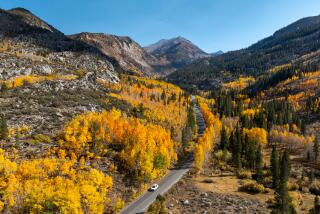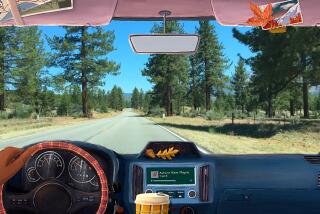A Postcard From Autumn, One Sunset Away From Winter’s Descent
- Share via
By happenstance, the events in the Mediterranean coincided with my 855-mile circumnavigation of the Southern Sierra searching for final days of Indian summer and having to dodge, instead, the first high country storm of winter.
There was no particular connection except that the trip helped reinforce an ad hoc law: The news tends to carry impact in inverse proportion to the distance from the home doorstep and in direct proportion to the proximity of a Sierra aspen grove or a crackling campfire on the banks of Lone Pine Creek.
Thus, the fate of the Achille Lauro was less immediate than the finding of a puddle-free campsite along the Merced River in soggy, dripping Yosemite Valley. Later, there was no Ted Koppel to explore the meaning of one or more bears playing badminton with a neighbor’s ice chest left overnight on a picnic table. The thumps and grunts spoke for themselves.
In the warm sunlight of El Capitan Meadow two mornings later, a couple from the Bay Area sat in lawn chairs, eyes stitched to binoculars and a telescope following the millimeter by millimeter progress of tiny climbers on an ocean of granite wall. “Watching people climb is the most boring thing in the world,” a climber had said the night before. But this was the couple’s second day of rapt attention to the colorful ant figures creeping to the summit of the North American Wall.
Then up and over Tioga Pass. Lacelets of new ice ringed the glacial tarns. Whipped cream clung to Fairview Dome. The great face of Mt. Conness sparkled. The Tuolumne Meadows store was a skeleton, its canvas sidings rolled up and packed away until next summer. Everyone had the same question: “How is the road over the pass?”
In the trough of Owens Valley and under the eaves of Mt. Whitney it was difficult to get more than snippets of the Mediterranean pursuit of the hijackers. The tinny radio signals spent themselves on the Coca-Cola Cowboy who “walked across my heart like it was Texas.”
This was to have been a trip to visit some high throne room of the Sierra one last time before winter--perhaps a long hike up the Lyell Fork of the Tuolumne or a dash in from Onion Valley over Kearsarge Pass. The rusty fall grasses would crinkle under hiking boots and the evening shadows would come in the afternoon, seeming to leap downward from ridge to ridge, racing the solitary hiker to the right spot for the night’s camp.
As the alpenglow recedes, the only sound might be the ripple of a stream, the flutter of the gas stove or the sudden whisper of a Boeing jet miles up in the deepening sky. At one instant, everything is still. And the next, the jet noise is there, faint but unmistakable. You cock an ear and an eye toward the noise, but already the jet has moved on. Then it leaps into the sunlight up where it still is day, and you wonder if the encased seat-belted and pressurized coastal commuters grasping their plastic cocktail glasses think about the black mountain shadows below and wonder if anyone is there.
But the storm forced instead a nibbling at the edges of the Sierra in search of autumn--a side trip into Convict Lake, a glimpse at the cathedral ridges of Mt. Morrison. There, at last, on the canyon walls, a few remaining aspens glittered orange-gold in the afternoon sunlight.
Along Lone Pine Creek just below Whitney Portal, the last wildflowers of the summer were dried blossoms perched on fragile stems. They seemed pressed in time, waiting for pelting snow to fold them under the oncoming winter blanket.
The campfire of Sierra pine indeed crackled and the leaping tongues of flame lashed themselves into fireflies. Above, the softly glowing spires of the Whitney crest faded into a canopy of starlight and dark.
John Muir wrote about such a Sierra autumn night years ago: “I linger by the fire, loath to go to bed.”
More to Read
Sign up for The Wild
We’ll help you find the best places to hike, bike and run, as well as the perfect silent spots for meditation and yoga.
You may occasionally receive promotional content from the Los Angeles Times.






